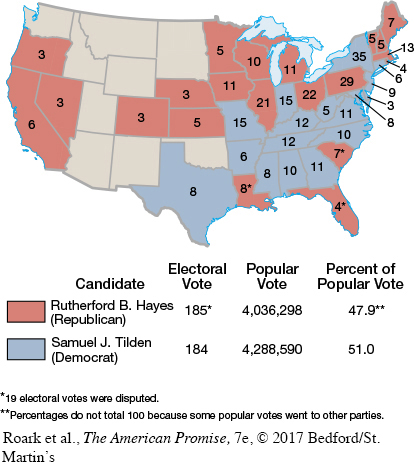The American Promise: Printed Page 465
The American Promise, Value Edition: Printed Page 423
The American Promise: A Concise History: Printed Page 484
An Election and a Compromise
The year 1876 witnessed one of the most tumultuous elections in American history. The election took place in November, but not until March 2 of the following year did the nation know who would be inaugurated president on March 4. Sixteen years after Lincoln’s election, Americans feared that a presidential election would again precipitate civil war.
The American Promise: Printed Page 465
The American Promise, Value Edition: Printed Page 423
The American Promise: A Concise History: Printed Page 484
Page 466The Democrats nominated New York’s governor, Samuel J. Tilden, who immediately targeted the corruption of the Grant administration and the “despotism” of Republican reconstruction. The Republicans put forward Rutherford B. Hayes, governor of Ohio. Privately, Hayes considered “bayonet rule” a mistake but concluded that waving the bloody shirt remained the Republicans’ best political strategy.
On election day, Tilden tallied 4,288,590 votes to Hayes’s 4,036,298. But in the all-

Congress had to decide who had actually won the elections in the three southern states and thus who would be president. The Constitution provided no guidance for this situation. Moreover, Democrats controlled the House, and Republicans controlled the Senate. Congress created a special electoral commission to arbitrate the disputed returns. All of the commissioners voted their party affiliation, giving every state to the Republican Hayes and putting him over the top in electoral votes (Map 16.4).
Some outraged Democrats vowed to resist Hayes’s victory. Rumors flew of an impending coup and renewed civil war. But the impasse was broken when negotiations behind the scenes resulted in an informal understanding known as the Compromise of 1877. In exchange for a Democratic promise not to block Hayes’s inauguration and to deal fairly with the freedmen, Hayes vowed to refrain from using the army to uphold the remaining Republican regimes in the South and to provide the South with substantial federal subsidies for railroads.
Stubborn Tilden supporters bemoaned the “stolen election” and damned “His Fraudulency,” Rutherford B. Hayes. Old-
REVIEW Why did northern support for Reconstruction collapse?